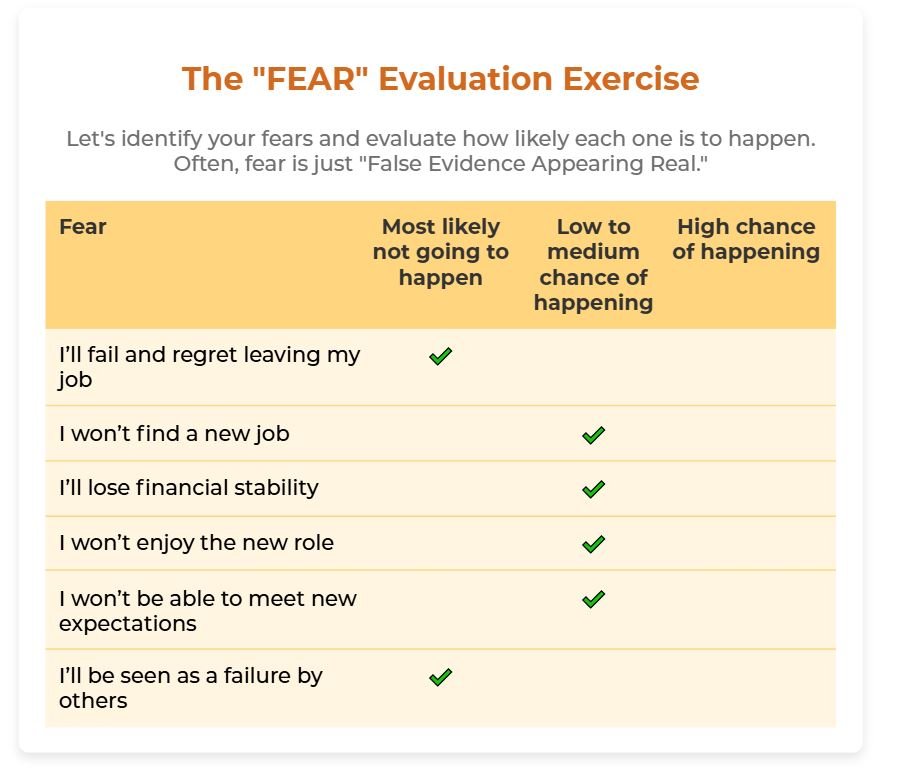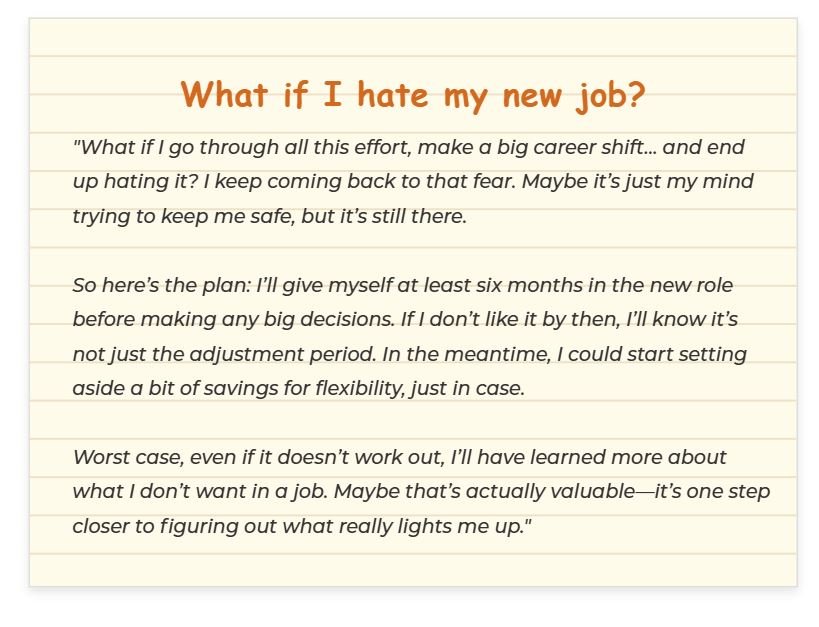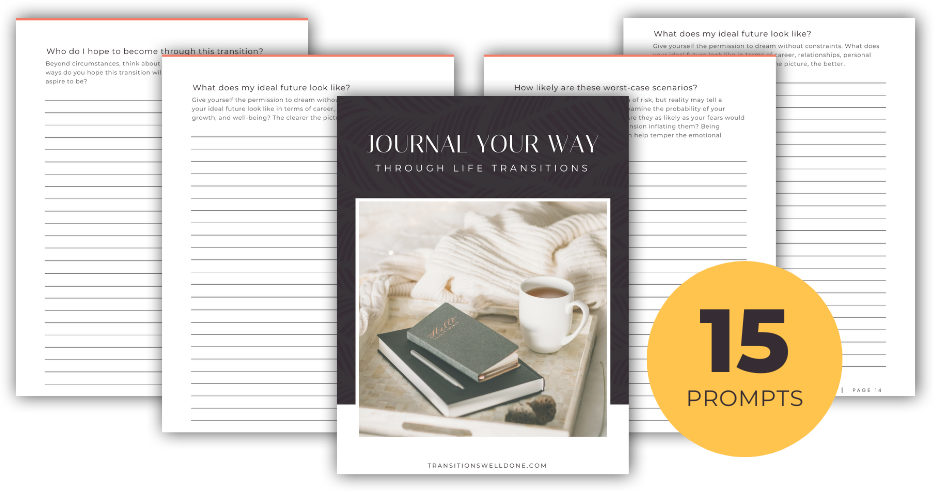7 Strategies to Help You Overcome Your Fear of Career Change
Thinking about a career change but feeling that familiar grip of fear? It's common to feel this way, especially when change touches the parts of our lives we hold closest. Change shakes up our routines, our comfort zones, even our sense of security—and with that comes doubt and hesitation.
In this post, I’ll walk you through practical ways to manage those fears so you can move forward thoughtfully. This isn’t about silencing fear entirely, but about giving yourself tools to handle it when it shows up—so you stay open, focused, and confident in your next steps.
1. Acknowledge and Understand Fear
First things first, let’s get real about what fear is here for. Fear isn’t the villain. In fact, it’s just doing its job by keeping you "safe." But sometimes, its version of safety is a life of staying small, of keeping things the same just because that’s what’s comfortable.
When we look at it closely, fear is really just resistance to change—a natural reaction in any life transition. It’s your mind’s way of shielding you from the unknown. And guess what? A lot of people feel the same way about career change—it’s common to feel like you’re about to jump off a cliff without a parachute. So, let’s take a second to appreciate fear for what it is: a signal, not a stop sign.
You don’t have to battle against fear. Instead, recognize it, and get curious about why it’s showing up. Is it because you’re afraid of failing? Worried about judgment? Fear of losing stability? When you start understanding what’s behind it, fear loses some of its power.
Try this:
Instead of diving straight into solutions, take a moment to simply notice the fear and explore what it’s telling you.
Here’s how:
Find a quiet space and identify what fears come up. Rather than solving them, simply name them as they arise, like “fear of failure,” “fear of instability,” or “fear of judgment.”
Instead of asking "What if," ask "What’s behind this fear?" Consider why this specific fear holds power over you—what past experiences, values, or beliefs are at its root?
BONUS: Free Guide to Reframing Limiting Beliefs
Ready to break through the mindset blocks that might be holding you back? Download my free guide, 10 Mindset Shifts for Bold Career Transitions, which walks you through powerful steps to challenge limiting beliefs. This guide will help you replace self-doubt with the confidence you need to take those bold steps toward your career dreams.
2. The “FEAR” Evaluation Exercise
I’ve got a little acronym for you: FEAR stands for “False Evidence Appearing Real.” Yep, most of our fears are made up of “what if” scenarios that may never happen. This exercise will help you identify which fears are rooted in real risk and which ones are just stories you’re telling yourself.
Try this:
Grab a pen and paper, and create a simple chart to map out your fears. Here’s how it works:
List each fear: Think of specific fears holding you back, like “What if I fail?” or “What if I don’t like the new job?”.
Assess the likelihood: For each fear, consider how likely it is to happen. Write it down under one of these categories:
Most likely not going to happen
Low to medium chance of happening
High chance of happening
Here’s an example:
By working through this exercise, you’ll start to see which fears are based on actual risks and which ones may be more about general anxiety or self-doubt.
3. Get Real with Your “What If” Questions
When fear makes you think, “What if I fail? What if this is a mistake?” try an honest check-in: What’s the worst that could realistically happen? Sometimes, fear isn’t about the actual change but the stories we tell ourselves about it. By identifying and addressing these stories, you’ll realize that many of your fears are likely rooted in uncertainties that can be managed.
Try this:
Write down your “what ifs” in a journal.
Address each one with realistic solutions. For example, if you’re worried you won’t find your footing right away, consider backup plans or smaller, actionable steps to keep you moving.
Rephrase them as growth opportunities.
Here’s what it could look like:
Just because you’re afraid of the unknown doesn’t mean it has to stop you. You’ve probably overcome bigger challenges before, right? This is just one more to add to the list.
6. Weigh the Pros and Cons
If you're feeling torn, creating a clear pros and cons list can be powerful. This isn’t just an old-school exercise; it’s a tool for emotional clarity, helping you see what’s at stake from a balanced perspective. When you’re face-to-face with your reasons for changing versus staying the same, the fog of indecision begins to clear.
Try This:
Divide a sheet of paper (or use the examples below) into four quadrants:
Pros of Making a Change
Cons of Making a Change
Pros of Staying the Same
Cons of Staying the Same
Allow yourself to be as honest as possible—write down even the tiniest fears and the smallest excitements. Sometimes, seeing it all laid out like this helps you find the clarity to take your next step.
5. Make a Plan to Ease Your Fear of Career Change
Let’s be honest: career change feels scary when you look at it as one big, life-altering leap. Suddenly, it’s like standing at the bottom of a mountain, looking up, and thinking, How am I ever going to do this? But what if you didn’t have to leap?
What if all it took was small, intentional steps that build up over time?
The trick is to break it down into smaller, manageable goals. These become the stepping stones toward your bigger vision. It’s a way of telling your brain, This is doable, so the fear doesn’t feel so paralyzing.
Try This:
Map Out Your Transition:
Define Your Vision – Get clear on what you want in your new career. The more specific, the better.
Set Key Milestones – Identify major steps you’ll need to take, like “updating my skills” or “expanding my network.”
Create Small Actions – For each milestone, list actions you can take this week. Think simple: reach out to one contact, set aside 15 minutes to update your resume, or schedule a weekend for skill-building.
Attach Timelines – Set realistic deadlines for each milestone to keep yourself moving forward.
When you break it down like this, you’re no longer staring down one big, scary goal. You’re just taking one small, intentional step at a time. Fear has a harder time creeping in when there’s a clear path forward. And the best part? With every step, you’re building momentum, confidence, and undeniable proof that you’re doing this.
6. Practice Mindfulness
Fear can feel like it’s on full volume when we start projecting every “what if” scenario into the future. Mindfulness is about coming back to this moment—right now—so we can find a sense of calm in the chaos. It doesn’t mean we ignore our fears. Instead, we acknowledge them, but we don’t let them lead the way. Mindfulness keeps us grounded in the present, empowering us to move forward with a sense of inner steadiness.
Try this: Mindful breathing exercise
This breathing exercise takes just 5 minutes but can make all the difference in quieting the mental noise:
Find a comfortable spot to sit, set a timer for 5 minutes, and close your eyes. Allow your body to relax—drop your shoulders, unclench your jaw.
Inhale deeply through your nose for a count of 4. Notice the sensation as your lungs fill with air.
Hold your breath gently for a count of 3.
Exhale slowly through your mouth for a count of 4, releasing tension as you breathe out.
Repeat this cycle of inhale-hold-exhale, focusing on the rhythm of your breath. Let any thoughts drift by without judgment, just bringing your attention back to each breath.
7. Build a Support Network or “Fear Buddy” System
You don’t have to do this alone. Change is hard, and having someone in your corner can make all the difference. Develop a trusted network or even a “fear buddy” who can listen, offer advice, and remind you of your strengths when self-doubt starts creeping in.
Try this:
Find a peer, friend, or mentor who’s made a recent transition. Check in with them regularly. Share updates, strategies, and insights. Support each other in staying committed and accountable.
And, if you’re ready to go deeper, consider Career Transition Coaching. Working with a coach gives you a unique blend of evidence-based strategies and emotional support that keeps you focused, aligned, and excited to keep going.






